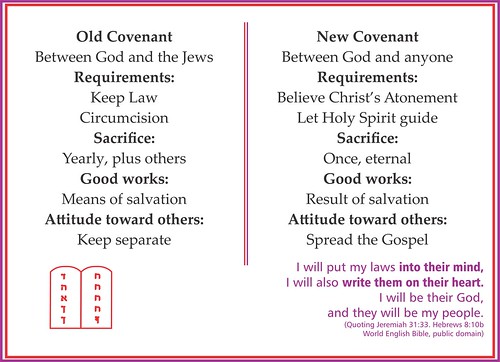
The graphic above is a link to the same picture, on my Flickr photostream. If you are interested, you may be able to see this picture at a larger size by following that link.
The quotation in the lower right is:
I will put my laws into their mind,
I will also write them on their heart.
I will be their God,
and they will be my people.
(Hebrews 8:10b, quoting Jeremiah 31:33)
World English Bible, public domain)
As I understand it, the new Covenant, and the need for it, explained in great detail in Hebrews, does not do away with the Ten Commandments. (The new Covenant is also called the New Testament.) However, it makes it possible to please God, in a way that the old Covenant did not, because the new Covenant establishes a relationship with God that the old one did not, and also has a much more radical, and effective, solution to the sin problem, that the old Covenant did not.
I used a graphic representation of the Ten Commandments to represent the Law of the First, or Old, Covenant. Jesus, or other New Testament writers, affirmed, in some way, every one of the Ten Commandments, except, perhaps, for the fourth, to remember the Sabbath. Jesus said that the Sabbath was made for man, not man for the Sabbath, in Mark 2:27. He also healed people, and picked grain to eat, on the Sabbath. (Matthew 12:1-12) Paul said that there should be flexibility in observing special days (Romans 14:6). There is abundant evidence, from the New Testament, that Christians thought that it was important to worship together. Now, most Christian groups do that in celebration of Christ's Resurrection, on Sunday. (The Jewish Sabbath was from sundown on Friday till sundown on Saturday.)
There were a lot of Ceremonial laws (some say about 600 or more) that the Jews believed that they should keep. They included things that seem strange to us (Exodus 23:19b says that a kid shouldn't be boiled in his goat mother's milk; Leviticus 19:19b says that clothing made of both linen and wool should not be used; there are instructions for dealing with mold (?) in cloth and houses in Leviticus 13). Then there were the dietary laws! (Most famously, Jews were not to eat pork, but there were quite a few other animals prohibited, too.) Peter saw a vision, in Acts 11, that was guidance from God that he could set those dietary restrictions aside, and, more important, that Gentiles could become Christians, without following the Jewish Ceremonial laws. The Jerusalem Council (Acts 15) relieved Gentile Christians of almost all of the Ceremonial Jewish Law. Paul, and the author of Hebrews, explained that the Law (First Covenant) was not able to reconcile people with God's desire to be free from sin. Belief in Christ's death and resurrection is able to do that.
I am not at all sure that the Hebrew symbols in the graphic of the Ten Commandments have any correspondence to the actual Hebrew of the Ten Commandments.
Thanks for reading!


12 comments:
Wonderful graphic and explanation! Yes, I'm very grateful that we gentiles can eat shrimp, crabs, and barbeque pork, especially!
Thanks, FancyHorse!
Great image. The only point that I would contend with is works as a means of Righteousness. According to the New Testament, many Old Testament figures were viewed as working because of their faith. Also, Jewish teaching would recognize that any Torah living was in response to the God who loved them.
I'm grateful for no more sacrifices. That would get expensive.
Yes, you are right, superrustyfly. There were characters like that. But most any diagram, about anything, is an oversimplification.
Expensive, and messy, and where would we find an altar, and a priest?
Awesome. Thanks for dumbing it down for me. Love it.
Dumbing it down? I guess that's what teachers (and preachers, maybe) try to do.
Thanks, Kerry i am.
I have greatly enjoyed reading your blog. Insightful, clearly written and practical. You might be interested to know that I am the grandson of Leon Stowe, your Yarnell schoolhouse preacher. Lawrence and Jack were my uncles, E.C. "Bill" Stowe is my father.
Thanks.
I went to Leon Stowe's church, in the schoolhouse, when I was 2 weeks old. Lawrence was my school bus driver, and Jack and I were in school together. I think your father was born while his parents were farm-sitting for my parents.
Based on the stories I've heard about Yarnell, I believe that that is probably correct. Grandpa Leon died before my mom and dad were married, so I never had the chance to meet him. But, I have heard a great many stories about those Yarnell years. It has been a pleasure reading your posts, but is now even more enjoyable knowing that our paths (in a manner of speaking) have crossed before. May God bless you and yours.
And you, also. Are you in contact with Michael Stowe, who would have been your cousin, I believe?
I'm the greatly blest "Bill" Stowe mentioned, by David Stowe, as being his father.
I have some thoughts about the two covenants that I trust, although different from your own, may not be altogether without merit:
1. I'm not able to find New Testament justification for viewing the Law given to Moses as being divisible into moral, ceremonial, civil, etc., commandments. I think the Law was, to Jesus, Paul, etc., simply the Law, period. It sank or swam as a unit.
2. To make a very long story very short: I am convinced that the new covenant written in human hearts--when combined with the teachings of the gifted first century church leaders--fully achieved, and continues to achieve, both the godly motivations and the godly conduct that fulfill the two "greatest" commandments of Matthew 22.
Thanks, Bill. Good to hear from you.
Post a Comment